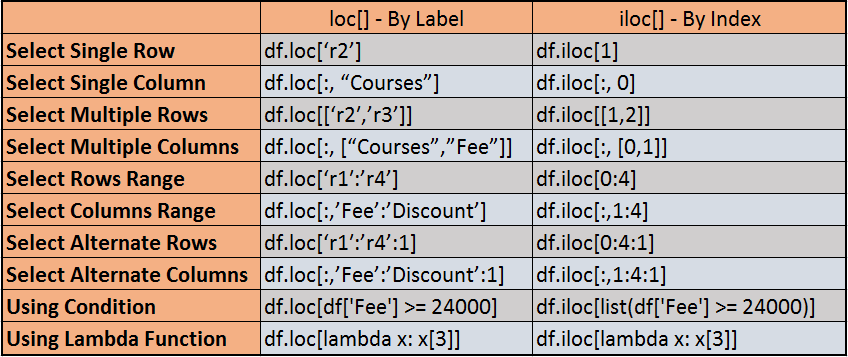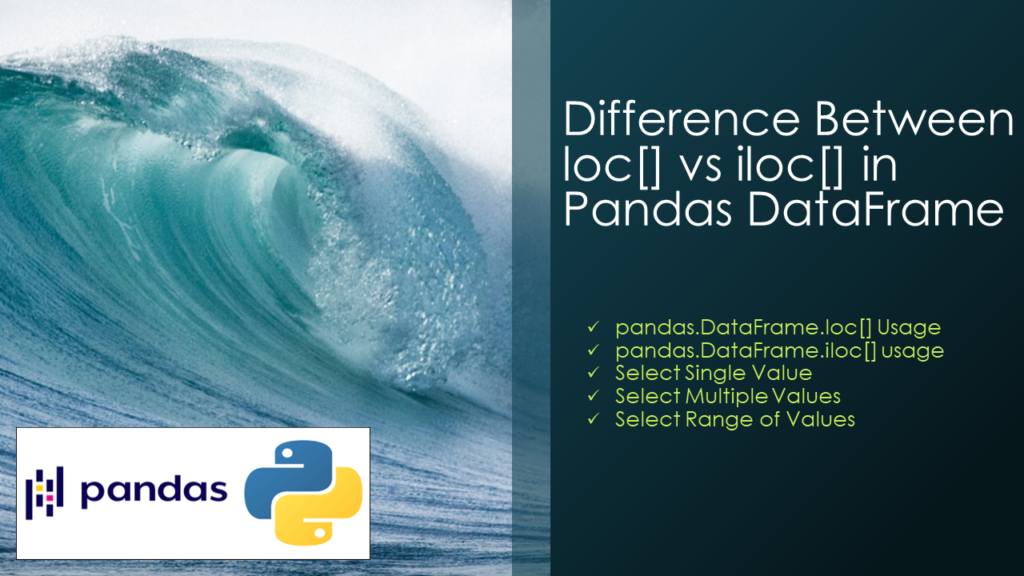In Pandas, both loc[] and iloc[] are indexing methods used to select specific rows and columns from a DataFrame. The main difference between pandas loc[] vs iloc[] is loc gets DataFrame rows & columns by labels/names and iloc[] gets by integer Index/position. For loc[], if the label is not present it gives a key error. For iloc[], if the position is not present it gives an index error.
In this article, I will cover the differences and similarities between loc[] and iloc[] in Pandas DataFrame by exploring with examples.

Let’s see the differences and similarities between loc[] vs iloc[] by using the below topics with examples.
- Pandas loc vs iloc Usage
- Select Single Value
- Select Multiple Values
- Select Range of Values
- Select Alternate Rows & Columns
- Using Conditions
Key Points –
loc[]is primarily label-based indexing, meaning it uses row and column labels to access data, whileiloc[]is integer-based indexing, using integer positions to access data.loc[]is inclusive of the endpoint when slicing, whereasiloc[]is exclusive of the endpoint, similar to Python slicing convention.loc[]is used to access data by label, allowing for explicit row and column selection based on their labels in the index, whileiloc[]is used for integer-based indexing, where rows and columns are accessed by their integer positions.loc[]allows for boolean array/mask indexing along with label-based indexing, enabling more flexible selection of data based on conditions, whileiloc[]strictly relies on integer positions.
Difference Between loc[] vs iloc[] in DataFrame
The difference between loc[] vs iloc[] is described by how you select rows and columns from pandas DataFrame.
loc[]is used to select rows and columns by Names/Labelsiloc[]is used to select rows and columns by Integer Index/Position. zero based index position.
You utilize the loc[] or iloc[] attributes to select or filter DataFrame rows or columns. These are mostly used attributes in pandas DataFrame. Let’s see the usage of these before jumping into differences and similarities.
pandas.DataFrame.loc[] Usage
DataFrame.loc[] is label-based to select rows and/or columns in pandas. It accepts single labels, multiple labels from the list, indexes by a range (between two indexes labels), and many more.

STARTis the label of the first row/column to include in the slice.STOPis the label of the last row/column to include in the slice.STEPindicates the interval between labels to include in the slice.
Some points to note about loc[].
- When you don’t provide a start column,
loc[]selects columns from the beginning. - If you don’t provide a stop column,
loc[]selects all columns from the start label to the end. - When you provide both start and stop columns,
loc[]selects all columns in between those two columns, inclusive of both start and stop columns.
pandas.DataFrame.iloc[] usage
DataFrame.iloc[] is a index-based to select rows and/or columns in pandas. It accepts a single index, multiple indexes from the list, indexes by a range, and many more.

STARTis the integer index of the row/column.STOPis the integer index of the last row/column where you wanted to stop the selection, andSTEPis the number of indices to advance after each extraction.
Some point to note about iloc[].
- By not providing a start index, iloc[] selects from the first row/column.
- By not providing stop, iloc[] selects all rows/columns from the start index.
- Providing both start and stop, selects all rows/columns in between.
Let’s create a DataFrame and explore the differences of loc[] and iloc[].
# Pandas.DataFrame.iloc[] usage
import pandas as pd
technologies = {
'Courses':["Spark","PySpark","Hadoop","Python","pandas"],
'Fee' :[20000,25000,26000,22000,24000],
'Duration':['30day','40days','35days','40days','60days'],
'Discount':[1000,2300,1200,2500,2000]
}
index_labels=['r1','r2','r3','r4','r5']
df = pd.DataFrame(technologies,index=index_labels)
print(df)
# Outputs:
# r1 Spark 20000 30day 1000
# r2 PySpark 25000 40days 2300
# r3 Hadoop 26000 35days 1200
# r4 Python 22000 40days 2500
# r5 pandas 24000 60days 2000
Select Single Value Using loc[] vs iloc[]
By using loc[] and iloc[] you can select the single row and column by name and index respectively. The below example demonstrates how to select row by label and index.
# Select Single Row by Index Label
print(df.loc['r2'])
# Select Single Row by Index
print(df.iloc[1])
# Outputs:
# Courses PySpark
# Fee 25000
# Duration 40days
# Discount 2300
# Name: r2, dtype: object
In order to select column by label and Index use below.
# Select Single Column by label
print(df.loc[:, "Courses"])
# Select Single Column by Index
print(df.iloc[:, 0])
# Outputs:
# Courses
# r1 Spark
# r2 PySpark
# r3 Hadoop
# r4 Python
# r5 pandas
Select Multiple Rows/Columns using loc[] vs iloc[]
To select multiple rows and columns, use the labels or integer index as a list to loc[] and iloc[] attributes. Below is an example of how to select rows by label and index.
# Select Multiple Rows by Label
print(df.loc[['r2','r3']])
# Select Multiple Rows by Index
print(df.iloc[[1,2]])
# Outputs:
# Courses Fee Duration Discount
# r2 PySpark 25000 40days 2300
# r3 Hadoop 26000 35days 1200
Similarly, to select multiple columns from a Pandas DataFrame, you can use the loc[] method with a colon (:) to specify all rows, followed by a list of column labels enclosed in square brackets
# Select multiple Columns by labels
print(df.loc[:, ["Courses","Fee","Discount"]])
# Select multiple columns by index
print(df.iloc[:, [0,1,3]])
# Outputs:
# Courses Fee Discount
# r1 Spark 20000 1000
# r2 PySpark 25000 2300
# r3 Hadoop 26000 1200
# r4 Python 22000 2500
# r5 pandas 24000 2000
Select Range of Values Between Two Rows or Columns
To select a range of values between two rows or columns in a Pandas DataFrame, you can use the slice notation within the loc[] and iloc[] methods.
# Select Rows Between two Index Labels
# Includes both r1 and r4 rows
print(df.loc['r1':'r4'])
# Select Rows Between two Indexs
# Includes Index 0 & Execludes 4
print(df.iloc[0:4])
# Outputs:
# Courses Fee Duration Discount
# r1 Spark 20000 30day 1000
# r2 PySpark 25000 40days 2300
# r3 Hadoop 26000 35days 1200
# r4 Python 22000 40days 2500
In the above example,
df.loc['r1':'r4']select rows from index labelr1tor4, including bothr1andr4.df.iloc[0:4]selects rows from index position 0 up to, but excluding, index position 4. It includes rows at index positions 0, 1, 2, and 3.
To select columns between two column names in a Pandas DataFrame, you can use the loc[] & iloc[] method with slice notation.
# Select Columns between two Labels
# Includes both 'Fee' and 'Discount' columns
print(df.loc[:,'Fee':'Discount'])
# Select Columns between two Indexes
# Includes Index 1 & Execludes 4
print(df.iloc[:,1:4])
# Outputs:
# Fee Duration Discount
# r1 20000 30day 1000
# r2 25000 40days 2300
# r3 26000 35days 1200
# r4 22000 40days 2500
# r5 24000 60days 2000
In the both above examples,
df.loc[:,'Fee':'Discount']selects columns fromFeetoDiscount, including bothFeeandDiscount.df.iloc[:,1:4]selects columns from index position 1 up to, but excluding, index position 4. It includes columns at index positions 1, 2, and 3 (Fee,Duration, andDiscount).
Select Alternate Rows or Columns
Similarly, You can select alternate rows or columns using both loc[] and iloc[] methods. For instance,
- To select alternate rows using index labels with a step size of
2using theloc[]method. - To select alternate rows by index positions using the
iloc[]method with a step size of2.
# Select Alternate rows By indeces
print(df.loc['r1':'r4':2])
# Select Alternate rows By Index
print(df.iloc[0:4:2])
# Outputs:
# Courses Fee Duration Discount
# r1 Spark 20000 30day 1000
# r3 Hadoop 26000 35days 1200
To selects alternate columns between two labels and two index positions using the loc[] and iloc[] methods
# Select Alternate Columns between two Labels
print(df.loc[:,'Fee':'Discount':2])
# Select Alternate Columns between two Indexes
print(df.iloc[:,1:4:2])
# Output:
# Fee Discount
# r1 20000 1000
# r2 25000 2300
# r3 26000 1200
# r4 22000 2500
# r5 24000 2000
In the above examples,
- The first example is selecting alternate columns starting from
Feeup toDiscount, with a step size of2. It includesFeeandDiscountcolumns. - The second example is alternate columns starting from index position 1 up to 4 (excluding), with a step size of 2. It includes columns at index positions 1 and 3 (
FeeandDiscount).
Using Conditions with loc[] vs iloc[]
Conditions can be applied to select specific rows or columns from a DataFrame using both loc[] and iloc[] methods.
# Using Conditions
print(df.loc[df['Fee'] >= 24000])
print(df.iloc[list(df['Fee'] >= 24000)])
# Output:
# Courses Fee Duration Discount
# r2 PySpark 25000 40days 2300
# r3 Hadoop 26000 35days 1200
# r5 pandas 24000 60days 2000
Frequently Asked Questions on Difference Between loc[] vs iloc[]
The primary difference lies in the method of indexing data. loc[] is label-based, meaning it accesses data based on row and column labels, while iloc[] is integer-based, accessing data based on integer positions.
When slicing with loc[], it is inclusive of the endpoint, meaning the rows and columns specified in the slice are included in the output. Conversely, iloc[] slicing is exclusive of the endpoint, following the convention of Python slicing.
loc[] supports label-based indexing, allowing explicit selection of rows and columns based on their labels in the index. On the other hand, iloc[] supports integer-based indexing, where rows and columns are accessed by their integer positions.
loc[] enables boolean array or mask indexing in addition to label-based indexing, facilitating flexible data selection based on conditions. iloc[], however, strictly relies on integer positions and doesn’t support boolean indexing directly.
Use loc[] when working with labeled data, especially when the index is meaningful, as it leads to clearer and more readable code. Conversely, iloc[] is preferred for operations where the order of rows/columns is more important than their labels, or when working with integer-based data.
Conclusion
In this article, I have explained the differences and similarities between loc and iloc in pandas DataFrame using examples. DataFrame.loc[] facilitates label-based selection of rows and/or columns in pandas. It supports single labels, lists of labels, ranges specified by two index labels, and additional selection methods. DataFrame.iloc[] is index-based to select rows and/or columns in pandas. it accepts a single index, multiple indexes from the list, indexes by a range, and many more.
Happy Learning !!
Related Articles
- How to Change Position of a Column in Pandas
- Append a List as a Row to Pandas DataFrame
- Pandas Shuffle DataFrame Rows Examples
- Pandas DataFrame reindex() Function
- How to Split Pandas DataFrame?
- Count NaN Values in Pandas DataFrame
- Pandas DataFrame count() Function
- Pandas Series loc[] Function
- Pandas iloc[] Usage with Examples
- Pandas loc[] multiple conditions
- Convert Pandas Timestamp to Datetime
- Pandas Get First Row Value of a Given Column
- Drop Single & Multiple Columns From pandas DataFrame
- How to Get Column Names as List From Pndas DataFrame
